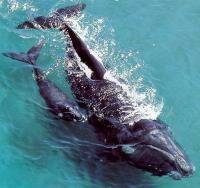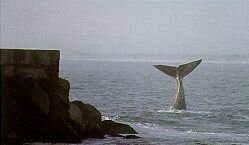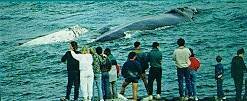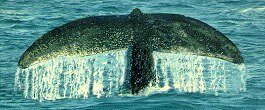|
The Southern Right Whale - Eubalaena Australis

The southern right whale is the most commonly seen whale along the South African coast. It is a robust baleen whale that grows to between 15 and 17 metres in length and weighs between 50 and 65 tons. It is mostly dark in colour with a white patch on the belly and lightly coloured callosities (described below) on the head, although about 4% of babies are born white and darken to a bridle colour as they age. The southern right whale has no dorsal fin, has a V-shaped blow, square-ish pectoral fins and a smooth, dark tail. It is well known for its extraordinary displays of breaching, flipper slapping and tail slapping which may carry on for minutes or hours.
"Eu" is Greek for right, "balaena" is Latin for whale and "australis" is Latin for southern. Right whales were named so as they were once the "right" whales to hunt and kill. The southern right makes use of the extreme coastal waters of South Africa each year to mate and calve, which made it an easy target for whalers. This species generally moves a slow pace which meant that there wasn't much of a chase and it's high yield of baleen (whale bone) and blubber (whale oil), products that the whalers sought, made it a choice catch. Being very fat animals, the southern right tended to float after being killed, which was an added bonus for whalers who often struggled with thinner species that sunk after being harpooned. The northern and southern right whales are very similar, although it appears that the two populations never mix. Northern rights go north to the Arctic to feed at the same time that southern rights move north toward warmer waters to calve and breed, and when southern rights go south to the Antarctic to feed the northern rights move southward toward warmer waters to calve and breed.
Right and bowhead whales generally eat the smallest planktonic crustaceans, called copepods as well as krill. The southern right whale is a skimmer, which means that it ploughs through the water (often at the surface) with its mouths open, filtering and sifting the concentrated swarms of plankton. Southern right have 225 to 250 pairs of long (2 metres in length and 30 cm in width) baleen plates and, naturally, the greatest exaggeration of the head which houses them. The head of the southern right is triangular and highly arched with a huge scoop-like lower jaw to accommodate the excessively large baleen.
The best time to see southern right whales is between June and November, when they make their annual + 2000 km journey from their cold Antarctic feeding grounds to calve and mate in the warmer coastal waters of South Africa. The southern right makes use of extreme coastal waters along the southern and south-eastern coastal region of the Cape, and sometimes as far north as southern KwaZulu-Natal. For an update on where whales have been sighted recently, or if you would like to report a sighting, contact the toll-free MTN Whale Hotline on 0800-22-8222.
The gestation period for southern right whales is around 11 or 12 months, after which the female gives birth to a calf of about 6 metres long. The peak calving season along our coast is in August. The new calf will suckle on about 600 litres of rich milk per day, which it gets from one of its mother's two nipples. The baby will grow about 3 cm in length per day while it remains along our coast and will suckle for 6 months to one year and about 8.5 metres in length. Mothers appear to fast for the few months while they are along our coast, relying on the fat or blubber that she stored while in the Antarctic a few months before. This blubber has to meet her nutritional needs as well as the calf's until they return to their feeding grounds.
Females that have given birth this year will nurse their young for six months to a year, they'll rest and recuperate for a year, and then they'll return to our coast about the third year to mate (apparently). Unlike the albatross, southern right whales do not mate for life, and in fact, they don't even mate for a season. They are promiscuous animals. Eligible females may be pursued by a number of males, as many as 6 or 7 males to one female. Mating is brief but frequent and most, if not all, of the males in the group will mate with the female. Each of the pursuing males is attempting to sire the females next calf, but there is a great deal of competition. Right whales don't have teeth or horns or claws to prevent the other males from mating with the female, so they have developed an interesting way to compete called "sperm competition". Each male produces massive amounts of sperm in an attempt to dilute other sperm that might already be in the female. To do this, the whales need the appropriate plumbing, which explains why one southern right whale testicle weighs in at about 500 kg. These organs are internal.
Callosities are patches of raised, wart-like skin which form around the rudimentary hairs on the head (over the eye, around the blow hole and on the upper and lower jaws) of right whales. The most prominent patch, termed the "bonnet", is found at the tip of the snout. The patches are light in colour, and appear even lighter due to the presence of whale lice (small crustaceans that feed on the whale's dead skin) and barnacles. Callosities have been a valuable tool to right whale researches, as they are unique in shape and design on each animal, thus making it possible to identify individuals. Thanks to callosities, scientists are able to estimate population size, track whales to their feeding grounds, follow calving cycles, and determine calving and survival rates of these animals. In 1994 the total population of southern right whales that visited this coast (including those here and those in the Antarctic) totalled between 1700-2000 animals. It appears that the population is increasing at a very healthy rate, doubling every 10 years, and the total number of individuals has surely increased since then. |
 The SOUTHERN RIGHT WHALE has a circumpolar distribution and inhabits sub antarctic water between about 30° and 55° south. The whales migrate south during the summer months when supplies of krill are more prolific, and north during winter and spring to mate, calve and rear their young. They appear around the South African coastline from May to December. They can be seen interacting in the sheltered bays and coves close inshore and near river mouths.
The SOUTHERN RIGHT WHALE has a circumpolar distribution and inhabits sub antarctic water between about 30° and 55° south. The whales migrate south during the summer months when supplies of krill are more prolific, and north during winter and spring to mate, calve and rear their young. They appear around the South African coastline from May to December. They can be seen interacting in the sheltered bays and coves close inshore and near river mouths.
 The "blow" is a cloud of vapour produced largely by condensation when warm breath comes into contact with cooler air and drops of water from around the blowhole being forced up with the rush of air as the whale breathes. It also contains oily mucus from the respiratory tract of the whale.
The "blow" is a cloud of vapour produced largely by condensation when warm breath comes into contact with cooler air and drops of water from around the blowhole being forced up with the rush of air as the whale breathes. It also contains oily mucus from the respiratory tract of the whale.

 Black Colour with occasional white markings along back and underside; the body is stocky and fat, smoothly rotund without a trace of dorsal fin or any ridge along the back.
Black Colour with occasional white markings along back and underside; the body is stocky and fat, smoothly rotund without a trace of dorsal fin or any ridge along the back.
 People can now phone from anywhere in the world to find out where the whales are along our coast. The Whale Hotline's office is in daily contact with all the information offices on the whale route from Plettenberg Bay to Lambert's Bay.
People can now phone from anywhere in the world to find out where the whales are along our coast. The Whale Hotline's office is in daily contact with all the information offices on the whale route from Plettenberg Bay to Lambert's Bay.